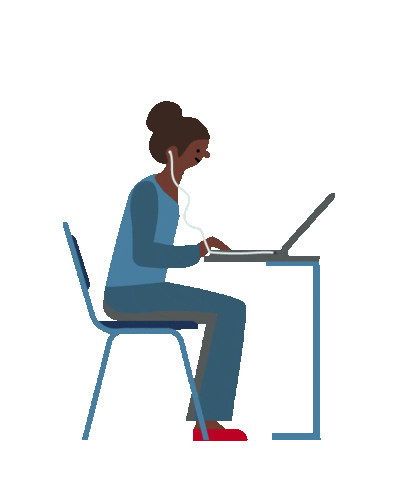
How are you all today?? i hope you all still stay safe at home because we have to break the chain of covid-19 together by stay at home😉
I will continue to give all of you the important information about teaching and learning. Today, i want to share with you all an article about The Implementation of Online Learning in Universities. As you all know, world nowadays was infected by covid-19 that make people can't continue their work as usual. This covid-19 also infected teaching and learning because school across the world have to shut down. For your information, globally over 1.2 billion children in 186 countries are out of the classroom.
In this situation, schools have to be flexible and find the other solution to undergo teaching and learning without harming the students's health. So, to prevent the students left behind in academic, most countries start to undergo teaching and learning on digital platforms. This platforms can help teachers continues teaching students without have to met their students face to face.
I want to share you all an article about the implementation of online learning in university. This article's title is "The Difference between Emergency Remote Teaching and Online learning" but what i want to focus here is the explanation about online learning and the effective of implement online learning in University. So, i make it short to make you all understand more but if you all want to read the full article you all can click this link https://er.educause.edu/articles/2020/3/the-difference-between-emergency-remote-teaching-and-online-learning
Before you read a long article about online learning in university, you can watch this short video about what is e-learning. Enjoy😍
The Difference Between Emergency Remote Teaching and Online Learning
Friday, March 27, 2020
Well-planned online learning experiences are meaningfully different from courses offered online in response to a crisis or disaster. Colleges and universities working to maintain instruction during the COVID-19 pandemic should understand those differences when evaluating this emergency remote teaching.
Due to the threat of COVID-19, colleges and universities are facing decisions about how to continue teaching and learning while keeping their faculty, staff, and students safe from a public health emergency that is moving fast and not well understood. Many institutions have opted to cancel all face-to-face classes, including labs and other learning experiences, and have mandated that faculty move their courses online to help prevent the spread of the virus that causes COVID-19. The list of institutions of higher education making this decision has been growing each day. Institutions of all sizes and types—state colleges and universities, Ivy League institutions, community colleges, and others—are moving their classes online.1 Bryan Alexander has curated the status of hundreds of institutions.2
Moving instruction online can enable the flexibility of teaching and learning anywhere, anytime, but the speed with which this move to online instruction is expected to happen is unprecedented and staggering. Although campus support personnel and teams are usually available to help faculty members learn about and implement online learning, these teams typically support a small pool of faculty interested in teaching online. In the present situation, these individuals and teams will not be able to offer the same level of support to all faculty in such a narrow preparation window. Faculty might feel like instructional MacGyvers, having to improvise quick solutions in less-than-ideal circumstances. No matter how clever a solution might be—and some very clever solutions are emerging—many instructors will understandably find this process stressful.
The temptation to compare online learning to face-to-face instruction in these circumstances will be great. In fact, an article in the Chronicle of Higher Education has already called for a "grand experiment" doing exactly that.3 This is a highly problematic suggestion, however. First and foremost, the politics of any such debate must be acknowledged. "Online learning" will become a politicized term that can take on any number of meanings depending on the argument someone wants to advance. In talking about lessons learned when institutions moved classes online during a shutdown in South Africa, Laura Czerniewicz starts with this very lesson and what happened around the construct of "blended learning" at the time.4 The idea of blended learning was drawn into political agendas without paying sufficient attention to the fact that institutions would make different decisions and invest differently, resulting in widely varying solutions and results from one institution to another. With some of that hindsight as wisdom, we seek to advance some careful distinctions that we hope can inform the evaluations and reflections that will surely result from this mass move by colleges and universities.
Online learning carries a stigma of being lower quality than face-to-face learning, despite research showing otherwise. These hurried moves online by so many institutions at once could seal the perception of online learning as a weak option, when in truth nobody making the transition to online teaching under these circumstances will truly be designing to take full advantage of the affordances and possibilities of the online format.
Effective Online Education
Online education, including online teaching and learning, has been studied for decades. Numerous research studies, theories, models, standards, and evaluation criteria focus on quality online learning, online teaching, and online course design. What we know from research is that effective online learning results from careful instructional design and planning, using a systematic model for design and development.7 The design process and the careful consideration of different design decisions have an impact on the quality of the instruction.
One of the most comprehensive summaries of research on online learning comes from the book Learning Online: What Research Tells Us about Whether, When and How.8 The authors identify nine dimensions, each of which has numerous options, highlighting the complexity of the design and decision-making process. The nine dimensions are modality, pacing, student-instructor ratio, pedagogy, instructor role online, student role online, online communication synchrony, role of online assessments, and source of feedback (see "Online learning design options").
Online learning design options (moderating variables)
- Modality
- Fully online
- Blended (over 50% online)
- Blended (25–50% online)
- Web-enabled F2F
Pacing- Self-paced (open entry, open exit)
- Class-paced
- Class-paced with some self-paced
Student-Instructor Ratio- < 35 to 1
- 36–99 to 1
- 100–999 to 1
- > 1,000 to 1
Pedagogy- Expository
- Practice
- Exploratory
- Collaborative
Role of Online Assessments- Determine if student is ready for new content
- Tell system how to support the student (adaptive instruction)
- Provide student or teacher with information about learning state
- Input to grade
- Identify students at risk of failure
- Instructor Role Online
- Active instruction online
- Small presence online
- None
Student Role Online- Listen or read
- Complete problems or answer questions
- Explore simulation and resources
- Collaborate with peers
Online Communication Synchrony- Asynchronous only
- Synchronous only
- Some blend of both
Source of Feedback- Automated
- Teacher
- Peers
Source: Content adapted from Barbara Means, Marianne Bakia, and Robert Murphy, Learning Online: What Research Tells Us about Whether, When and How (New York: Routledge, 2014).
Within each of these dimensions, there are options. Complicating matters, not all of the options are equally effective. For example, decisions around class size will greatly constrain what strategies you can use. Practice and feedback, for example, are well established in the literature, but it's harder to implement this as class size grows, eventually reaching a point where it's just not possible for an instructor to provide quality feedback. In the case of synchrony, what you choose will really depend on your learners' characteristics and what best meets their needs (adult learners require more flexibility, so asynchronous is usually best, perhaps with optional synchronous sessions, whereas younger learners benefit from the structure of required synchronous sessions).
Research on types of interaction—which includes student–content, student–student, and student–learner—is one of the more robust bodies of research in online learning. In short, it shows that the presence of each of these types of interaction, when meaningfully integrated, increases the learning outcomes.9 Thus, careful planning for online learning includes not just identifying the content to cover but also carefully tending to how you're going to support different types of interactions that are important to the learning process. This approach recognizes learning as both a social and a cognitive process, not merely a matter of information transmission.
Those who have built online programs over the years will attest that effective online learning aims to be a learning community and supports learners not just instructionally but with co-curricular engagement and other social supports. Consider how much infrastructure exists around face-to-face education that supports student success: library resources, housing, career services, health services, and so on. Face-to-face education isn't successful because lecturing is good. Lectures are one instructional aspect of an overall ecosystem specifically designed to support learners with formal, informal, and social resources. Ultimately, effective online education requires an investment in an ecosystem of learner supports, which take time to identify and build. Relative to other options, simple online content delivery can be quick and inexpensive, but confusing that with robust online education is akin to confusing lectures with the totality of residential education.
Typical planning, preparation, and development time for a fully online university course is six to nine months before the course is delivered. Faculty are usually more comfortable teaching online by the second or third iteration of their online courses. It will be impossible for every faculty member to suddenly become an expert in online teaching and learning in this current situation, in which lead times range from a single day to a few weeks. While there are resources to which faculty can turn for assistance, the scale of change currently being required on many campuses will stress the systems that provide those resources and most likely will surpass their capacities. Let's face it: many of the online learning experiences that instructors will be able to offer their students will not be fully featured or necessarily well planned, and there's a high probability for suboptimal implementation.


